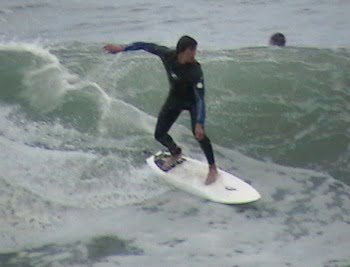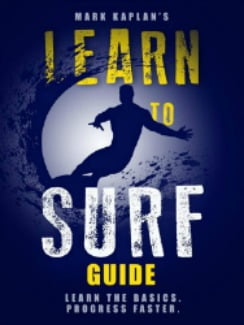Beginner Surfers Learn to Ride Real Waves
Beginner surfers learn to ride real waves after mastering techniques of riding foam waves. Once beginners can catch foam waves and ride to the beach in the correct posture, they are ready to progress.
The first progression is to start paddling out through foam waves to turn around and catch the next foam wave. This creates familiarity and comfort selecting the right waves and avoiding getting hit with the wrong ones. In Oceanside, there are small real waves coming in amongst the foam waves. New students can select whether to attempt real waves or just ride the foam ones.

The Fundamentals of Catching Real Waves
New students will find the transition from foam waves to real waves requires more courage. Real waves arc and are open just a few seconds, so the surfer has to be in the right spot. Missing the opening means you miss the wave or if you are too far in front, it crashes on you. It takes practice to get in the right spot.
The second thing new surfers learn is that the speed is greater going down the face of a real wave than riding a foam wave. This frequently causes a little panic and beginners often lean back and fall off the surf board or pearl (nose under water).
The reasons most students pearl is that instead of catching the real wave is they put their hands in front of their shoulders and push the nose down. Hands should always be placed next to the chest in a man’s push up position. I give my students a count to follow for the sequence of popping up. It is paddle, stop (hands on the board), push, back foot on the surf board, stand up, and then front foot on the surf board. The count is shortened in words as code for each step.
A mistake beginners often make is in their panic, they just put their hands on the board and jump up without precision nor poise. If you watch surfers out in the line up or video, you will see they are smooth and have a rhythm. You can’t jump on the board and hope to be lucky. You have to use the right technique.
Paddling is important. Most surfers catching real waves wait until the wave has risen under the surfboard and then with three strong paddles move the surfboard down the wave. Then they put their hands on the board in the man’s push up position, push, and then pop up. The paddling can’t be too few or too many. You learn the timing and rhythm with practice.
Learn More
For Oceanside Surf Lessons, see the Home Page
See the Post Surf Lessons Begin with Foam Waves
See the Post What You Learn in a 2 Hour Lesson
See the Post How to Progress in Surfing
See My Dry Land and In Water Demo video
See How to Catch a Green/Real Wave video
i have lowered my book and course prices for the lock down.
My New Surfing Course in an E-Book plus Demo Video
Get the 18 Chapter, 7,500 word Course that can prepare you for a lesson or give you the fundamentals if you are going to try it on your own. 10 years of teaching 350 students a year has given me the insights on the most precise measures you must follow for success. This course is what I teach on the dry land and in water instruction. The Course includes a 15 minute video on my dry land and in water demonstration. Only $4.95
Buy the E-book for $2.99. Learn to Surf (Different cover but same book)
Buy the Paperback on Amazon $6.95
Get Learn to Surf Course in 29 minute audio. Great prep for a lesson, reviewing after a lesson, learning on your own, refreshing after not having surfed for a while. See Table of Contents. Only $7.95

80 page Learn to Surf Book
![Surf Instructions Beginner to Advanced: Learn to Ride Waves by [Kaplan, Mark]](https://images-na.ssl-images-amazon.com/images/I/51HswFtoBQL.jpg)